Putin has revived the druzhinniki, the volunteer auxiliary police who maintain order on streets and in courtyards.
Welcome to our column, Russia Update, where we will be closely following day-to-day developments in Russia, including the Russian government’s foreign and domestic policies.
The previous issue is here.
UPDATES BELOW
Russia This Week:
– From Medal of Valor to Ubiquitous Propaganda Symbol: the History of the St. George Ribbon
– What Happened to the Slow-Moving Coup?
– Can We Be Satisfied with the Theory That Kadyrov Killed Nemtsov?
– All the Strange Things Going On in Moscow
Special features:
– With Cash and Conspiracy Theories, Russian Orthodox Philanthropist Malofeyev is Useful to the Kremlin
– Alexey Navalny On the Murder of Boris Nemtsov
– Theories about Possible Perpetrators of the Murder of Boris Nemtsov
– Novaya Gazeta Releases Sensational Kremlin Memo
Please help The Interpreter to continue providing this valuable information service by making a donation towards our costsâ€.
As we reported last week, Novaya Gazeta published a leaked report from engineers who said their research indicated that Malaysian airliner MH17 was shot down from another location, Zaroshchenskoye, instead of near Snezhnoye, the area widely reported by eyewitnesses and journalists. While the engineers conceded that the plane was likely hit by a Buk missile, they claimed it had to be a Buk in the Ukrainian Armed Forces, because it was supposedly in territory they held.
We debunked the engineers’ report by pointing out the existing evidence and the maps of battles at the time, which showed the area in fact was in Russian-backed separatist hands, and cited the past body of evidence pointing to a launch from near Snezhnoye.
Novaya Gazeta‘s publication of the flawed report caused many to wonder if they were under pressure from the government to push their new line, as the release of the Dutch experts’ finding grows closer and the Kremlin’s version of events involving an SU-25 plane firing at MH17 isn’t holding up.
Then Novaya Gazeta published another account of the downing of MH17 by Mark Solonin, an aviation engineer and aircraft designer as well as World War II historian who challenged their previous report.
Curiously, Novaya Gazeta does not explain why they did not simply publish the two reports simultaneously, or explain originally that the second one was coming. In their first publication, they claimed that journalists were not qualified to make judgements about MH17. In their second publication they said defensively they had been attacked as “agents of the FSB and [Defense Minister Sergei] Shoigu]” and seemed to plead for tolerance in examining all perspectives (translation by The Interpreter):
Public research of the tragedy presupposes the juxtaposition of different perspectives and conclusions of analysts, experts, historians, political analysts, witnesses, participants in the events, and the comparison of arguments from materials of the investigation which have been cited in Russia, Ukraine, and the Netherlands regardless of whether someone likes the facts and arguments or not.
Yet local citizen journalists in Ukraine and Russia and journalists from mainstream media in the region and abroad have already put together a huge body of evidence that challenges the Kremlin’s narrative. As we reported last July, even the basic facts of the separatists’ own bragging in their own social media groups as well as for state or pro-Kremlin media let us know that the story of a Russian Buk in rebel-held territory backed by Russian tanks cannot be suppressed.
There is no need to patiently hear out Russian state TV ideologues with transparently photoshopped materials when citizen journalists and Western reporters already have multiple videos showing a scene near Torez with plumes of smoke consistent with a rocket, before plumes of smoke of an aircrash.
As for the engineers’ report, as we noted, examination of elaborate trajectory and impact calculations aren’t persuasive when basic reporting and maps from both sides in the conflict show that there were no Ukrainian forces in the area claimed.
As we did last week, the second Novaya Gazeta publication this week includes the maps of the Ukrainian National Security Defense Council of that time period which show the area was not under Ukrainian control. For good measure, they might have included the pro-Russian bloggers’ battle maps, which show the same thing from their perspective.

The second report then contains an elaborate challenge to the previous report by the engineers, with trajectory of the calculations and impact points which are different and which the author say proves that the theory of Zaroshchenskoye as the launch site is mistaken. Solonin includes drawings of the impact first from Snezhnoye and then from Zaroshchenskoye to conclude the former was likely.

Map marked by Slononin showing the path of MH17, the point of impact, and the towns of Zaroshchenskoye and Snezhnoye, showing the point where the cockpit broke off in the first diagram and the place where the missile likely hit on the fuselage.


Solonin also makes the point that in theory, determining the place of launch from the damage to the plane isn’t generally possible, although he then says that in this case, it may be. Of course these issues are difficult to assess until the Dutch investigators’ report is published.
Today RFE/RL published the report of InformNapalm which has come up with another important piece of evidence from trawling the pages of Russian soldiers on Russian social media:
However, the activist group InformNapalm has found photographs on the VKontakte page of a Russian soldier named Dmitry Zubov that seem to detail the convoy’s June 2014 journey.
According to Zubov’s posts on VKontakte — his account on the Russian
social-media site has subsequently been closed down, but InformNapalm
saved cached copies — he was serving with the 147th Automotive Logistic
Support Battalion, Unit 83466, based just outside of Moscow. At the
time, he was serving his last few days before being demobilized.
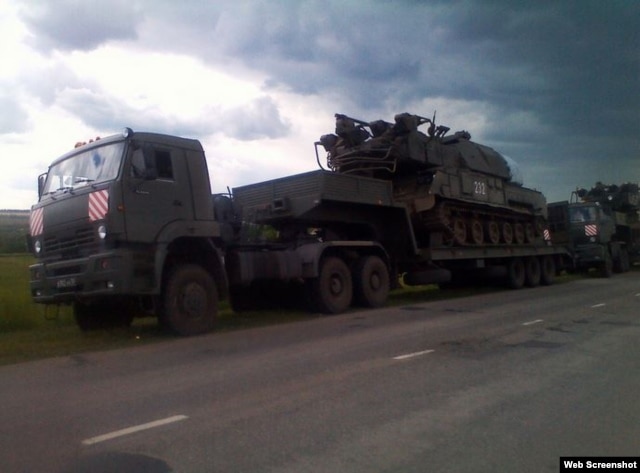
Buk photo from soldier’s VKontakte page.
A frequent problem in verifying the InformNapalm stories based on VKontakte is that as soon as they publish the material, the soldier so highlighted often deletes his page or pictures in fear of retribution. In this case, the account was even replaced with other names. The work could gain more credibility if they first contacted mainstream journalists and showed them the links and pictures before publication so that they can be verified by another party, then published them. It can be difficult, however to get the attention of Western journalists without the Russian language or who have moved on from the story of the war in Ukraine which these dedicated bloggers stick with day after day.
These stories are most compelling when multiple sources for the same claim can be found, such as this research by Aric Toler with multiple photos of the same dogs at the Russian army camp.
In the case of the Buk story today, a second source was found on Instagram which is still viewable showing the Buk with a hashtag “Stary Oskol,” a city in southern Russia and apartment buildings that appeared consistent with those on the main road where videos had also captured the convoys. The author said the convoys were headed in the direction of Ukraine.
Last year, The Interpreter was the first to geolocate two videos of these convoys with Buks in Stary Oskol. This Russian town is about 3 hours from the Ukrainian border. We could establish the likelihood that these convoys were headed into Ukraine, as others we had identified inside Ukraine had originated from Russia, but to prove this took many months of work by the team at Bellingcat, who were able to match the vehicles through various identifying traits.
In their work, Bellingcat used photos taken by a Le Monde reporter, videos of the convoys taken by citizens, a photo of a Buk in a shopping center parking lot in Torez and a video of a Buk truck minus one missile in Lugansk released by the Ukrainian Interior Ministry. They also got a lucky break with the posting by a Russian blogger on social media of one of the Buk vehicles in an area with buildings with distinctive features enabling the geolocation of the convoy.
As with many of the seeming “miracles of crowd-sourcing,” the reports don’t just originate from “the crowd” of online enthusiasts. They are actually often made up by a combination of old-fashioned government intelligence information leaked to social media; ordinary citizens who sometimes unwittingly post military pictures videos of significance while they are driving around or picnicking; local bloggers using pseudonyms who rarely get credit for their work although they take the greatest risk; and professional journalists willing to spend the time and resources to parse the masses of data, all of which require corroboration with other digital media to make a compelling story.
One of the hazards of the “crowd-sourcing” business is that many anonymous or pseudonymous social media users can be involved, and it’s always possible that Russian or other hostile intelligence agencies could be planting disinformation — as occurred soon after the downing of MH17 with the Buk video story by the Defense Ministry, which we exposed.
A report released yesterday in Moscow by the colleagues of Boris Nemtsov, Putin.War, also contains a chapter on the downing of MH17, a subject about which Nemtsov and Leonid Martynov had already made a Russian video which attracted more than one million views.
The chapter reprints the work of blogger Sergei Parkhomenko published in March 2015 in Meduza. This material goes over the same ground originally discovered by the blogger @DaveyPetros of Ukraine@War who worked with the journalist Ronald Oliphant who visited the fields outside of Snezhnoye to try to reconstruct the line of sight in a photo published in social media of the plume of smoke from the firing on the Buk. Dutch journalist Olaf Koens of RTLNiews also found the photographer and obtained additional photographs of the area.
Parkhomenko identified more of the details in the picture covered by the other bloggers and mapped them to Google Earth.
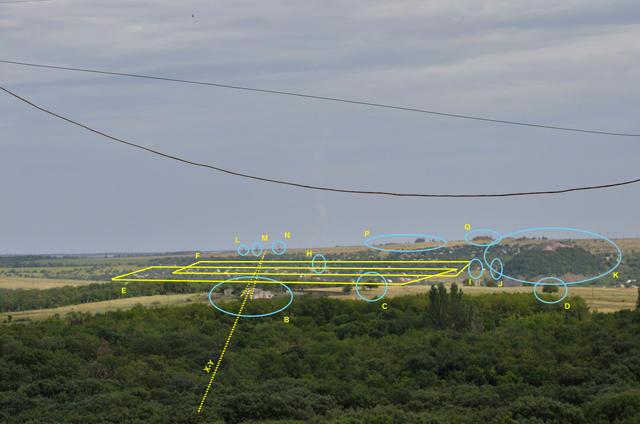
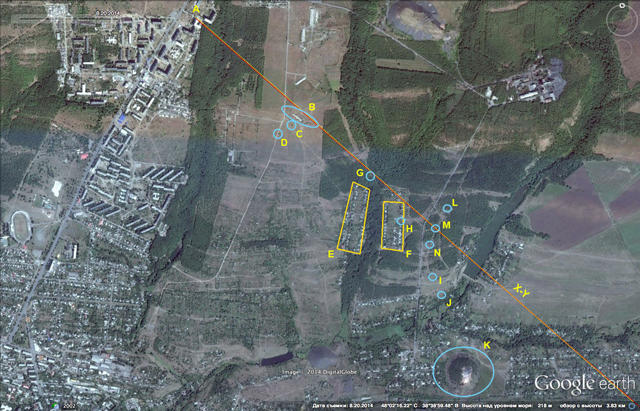
Before and even after the Dutch report emerges, we are likely to see more of these efforts from Russia, both disinformation reports and good-faith efforts to reconstruct the events and social media posts providing further corroboration.
What will matter is the ability of Western powers, especially those most affected by the tragedy, to stand up to the inevitable Kremlin disinformation and dissembling that will occur regarding the facts of trajectories and fragments and smoke plumes — or what can be particularly compelling for the Western value of adversarial debate, a call to “keep an open mind” and “look at all the theories.”
Most of the civilized world now accepts that MH17 was shot down by Russian-backed militants with a Russian-supplied Buk system in Russian separatist-controlled territory — which is what the separatist leader Col. Igor Strelkov said in the first hours in statements later deleted from social media but which still remain on the web sites of Russian media who sourced their stories about the plane from separatist fighters.
Since that time, only more eyewitnesses, pictures, videos and reports have come forward that tend to reinforce the original narrative clear from the conversations of a group of villagers gasping at the scene in their back yards, particularly the exclamation of one person about the “militia’s” weapon system brought from Russia: “They didn’t bring it in vain.”
— Catherine A. Fitzpatrick
Today opposition leader Alexey Navalny faced yet another court proceeding, this time to determine whether a petition from the Federal Corrections Service (FSIN) to send him to serve a five year sentence would be approved, Media Zone reported.
The sentence was from the Kirovles case, where he was charged with fraud in a lumber sale. He was given a suspended sentence at the time and allowed to run for mayor of Moscow, where he got about 30% of the votes.
FSIN had demanded his suspended sentence be turned into a real one because he kept being detained for demonstrations and leafletting, thus violating the terms of parole in their view.
TV crews were not allowed to film the court proceedings. Correspondents from NTV, which is notorious for being an arm of state propaganda and harassment of dissenters, called out to Navalny, asking him why he was meeting with the Hungarian ambassador and whether Mikhail Khodorkovsky funded him.
His supporters tweeted a list of all his arrests and court cases in the last year which besides the Kirovoles case, involved the Yves Roches East case for which his brother was sentenced to 3.5 years in labor colony and he himself was given a 3.5 year suspended sentence; for writing an article in the New York Times; for meeting Roman Rubanov, head of his Anti-Corruption Fund; for giving interviews to journalists; and for leafletting in the metro.
FSIN testified that Navalny violated the terms of his house arrest by going to pickets and demonstrations
Navalny
kept up his sense of humor during the proceedings and in his
self-defense said that he was exposing state corruption which the
authorities should appreciate.
The judge found that Navalny had
in fact committed two administrative offenses but they were a year apart
but he had maintained the conditions of his parole otherwise, and
therefore extended his parole another 3 months.
Translation: At Lyublino Court for some reason there’s a picet about Serdyukov. Or about Yakunin. Or about Sechin.
The picketer is in fact opposed to Navalny, but he is joking that his sign “A Thief Should Sit in Jail” could apply to one of the officials Navalny has exposed in corruption.
Translation: This photo document from the materials of the case was a decisive argument in favor of a suspended sentence. It proves everything.
The images are from the cartoon “My Little Pony.”
Translation: “I hold discussions with you as well; I tell you about how your Reymer is a thief and I turned out to be right.”
As we reported, Aleksandr Reymer is an official of the Federal Corrections service under who was arrested and is now under investigation for corruption.
(Note: The Interpreter is a project of the Institute for Modern Russia which is funded by Pavel Khodorkovsky, the son of Mikhail Khodorkovsky).
— Catherine A. Fitzpatrick
Under Putin, the special status of the Cossack communities was revived and even funds from the state budget provided to maintain Cossack patrols. Some of those groups have gone to fight in the Donbass. In Bashkortostan, says Kommersant, assault of a Cossack is treated the same as an assault on the regular police and is punishable by up to 10 years or even life. Cossacks plan to deploy on streets, woods, “among wildlife,” and on state borders and also take part in elections.
In 2013, Cossacks patrolled market places, which were places of tension and fights among migrant laborers or clashes between native Muscovites and the migrants. Not everyone was happy with their role.
Kommersant says the druzhinniki are being trained both to use physical force and also provide first aid. After the law on the volunteer police was passed last April, the Interior Ministry approved of a program to train 20,000 civilians in legal issues, psychological and physical preparation and also medical preparation. It got started last July, amid concerns about its costs.
Nikolai Yeremichev, the ataman of leader of the Kuban Cossacks Community in Moscow said (translation by The Interpreter):
In the South East District they are not the national Cossack organization but just an organization of local citizens who live in the South East District. The Cossacks there serve as the very people’s patrol which existed in the Soviet time. These people are not bureaucrats, not officials of state bodies, and not economically interested so as to close their eyes in exchange for “a chocolate.” These are people who live there, who have their eyes on the issue. It’s possible their participation will lead to greater clarity in the work of such a commission, to greater real oversight which likely is what attracts them.
Leonid Makurov, head of the capital department on Cossack affairs said Cossacks will deploy in groups of 50 in each district. They will work for free, but have free passes to public transit. On their first “experimental” raid, the Cossacks seized a woman selling blouses at the Belarus Station, chased off a babushka selling mushrooms and also said they would fight any “false Cossacks”. But the Central Administrative District said these particular Cossack groups were not coordinated from their office and was “a personal initiative.”
In March, the Presidential Council for Cossack Affairs approved a plan for a paid contract between the authorities in Moscow and the Cossacks, but to deploy them in woods and reserves and restore forested areas.
Ilya Varlamov, founder of the City Projects Foundation and a blogger commented to Kommersant:
“They have no relationship to real work. It is not very clear why these issues are on the agenda, that some kind of Cossacks or other organizations will help the police. It means the police are not coping with the elementary maintaining of order, and that’s very terrible, taking into account the number of police per capita. Russia is one of the leading countries on this parameter.
The PR people of our government cannot think of a more relevant topic. Before this, there were some kind of youth movements, they were patrolling something. Then the Cossacks came to replace them. We’re waiting for the next creative project, I hope it will be something more interesting. The Olympic leopard or the bear or a rabbit. The rabbit will patrol children’s playgrounds, the leopard — the markets and the bear will go along Tverskaya Street and along Red Square to the delight of tourists. It will be pretty.”
In the Trans-Baikal, the site of wildfires recently, Cossacks were deployed to maintain order during the May public holidays, zabinfo.ru reported.
Igor Shunkov, chief of the Trans-Baikal Region police, said 3,000 regular police would be deployed, and would be helped by 47 druzhinniki, 166 private security guards, 76 Cossacks, 39 plainclothes police, 278 public figures and about 100 people from other law-enforcement agencies.
Three years ago, as Kommersant reports, a Russian Orthodox group called Svyataya Rus’ (Sacred Rus’) took it upon themselves to patrol streets and cafes in Moscow and confront youths that they felt were “blasphemous,” such as people wearing Pussy Riot t-shirts.
The Interior Ministry at the time did not acknowledge them and said it was “premature” to talk about official approval for such patrols.
They were never institutionalized in the way the Cossacks are being established, but some groups have gone to disrupt showings of Ukrainian films or Ukrainian-related demonstrations.
— Catherine A. Fitzpatrick
Street patrols which President Vladimir Putin called to renew in his speech to the Interior Ministry in March are now being deployed, Kommersant and Gazeta.ru report.
Right after opposition leader Boris Nemtsov was assassinated in March, President Vladimir Putin spoke at the annual meeting of the Interior Ministry and called for “an end to political murders” in Russia.
This part of his speech was widely reported as a positive and even exculpatory statement, but it was only one quote from his speech. After that he used the fact of this murder on the street to make a larger point about the need to patrol city streets and deter street crime — although Nemtsov’s murder was a planned assassination, not a street fight.
Putin noted that the number of crimes in public places had increased by 8.5% and extremist crimes of “militant nationalism, intolerance and aggression” by 15%.
“What this can lead to we see very well with the example of our neighboring country, Ukraine,” he cautioned — although he meant not the Russian-backed militants, many who came from corrupt law-enforcement or the criminal underworld who took over buildings in the Donbass, but Ukrainian ultranationalist groups, some of which have fought in voluntary battalions.
There have been several incidents of fist-fights, gunfights and even murders of policemen in Russia that have been committed by fighters returning from the Donbass. The reasons for the sharp increase in street crime and extremism haven’t been stated, but many associate it with a more aggressive tone in state media.
Putin outlined a plan to revive the druzhinniki or auxiliary police following a law passed in April of last year. The people with red arm-bands were known in Soviet times and were sometimes used to harass activists at the rare demonstration or more common political trial but were mainly deployed to add to the already intrusive police presence in apartment complexes and to handle crowds at public events.
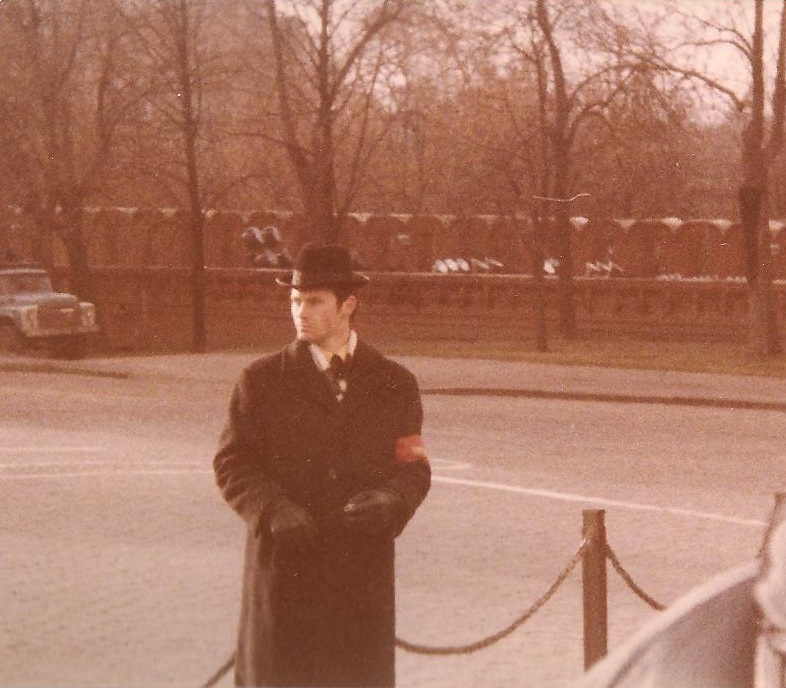
Druzhinnik in Moscow in 1978 near the Kremlin. Photo by Catherine A. Fitzpatrick
Now the ruling party, United Russia, has announced that they will provide the volunteers in a project called “Safe Capital,” Kommersant reports.
United Russia says they will patrol Moscow streets and courtyards. They are looking for volunteers of “strong athletic build” from the “around the fighting brotherhoods” — a reference to an organization of veterans called Battle Brotherhood, founded by former Afghan major Boris Gromov, who was governor of Moscow Region for a time, and now promoted by Dmitry Sablin, member of the Federation Council.
Other groups they said they would recruit from included the Union of Paratroopers of Russia, the Union of Veterans of the Vilnius and Riga OMON or riot police, and also among Cossacks. The participants will cooperate with the system of police public security booths known as OPOP and will wear the “party uniform” with its trademark bear.
United Russia says they won’t be tied to the Anti-Maidan movement although Battle Brotherhood is among its founders and they concede that they will maintain order at public rallies along with police. They said they will focus on illegal parking and illegal drug sales. They expect to make raids on stores to see if all the goods in them are legal and swoop down on people getting high in playgrounds.
Even though we are recruiting strong guys, they must be able to talk — for example to the grandmothers on the benches about what concerns them.
Currently, they undergo 12 hours of training says Kommersant.
The patrollers are going to make a map of “crimogenous zones” and “conflict centers” in concert with the department of public safety in the mayor’s office.

A volunteer dons the druzhinnik armband. His vest says “Migration Control” in Russian and English to enable him to chase illegal migrants.
The druzhinniki say they are needed because there is only one cop on the beat per 2,000-3,000 residents. They tested the program in three districts of Moscow including Lyublino, which aside from being known as an area of gang fights is the electoral district of Inna Svyatenko, the United Russia member who is head of the Moscow City Duma safety commission and who will lead the Safe Capital program.
Mikhail Velmakin, municipal deputy from the Otradnoye District told Kommersant that “nothing useful” would come out of the project.
“It’s a PR move, nothing more. There have been many attempts to create the institution of druzhinnikov and nothing has come of it. In any event, they don’t have the authority the police officers do.”
The patrols are expected to raise the ratings of United Russia, which have slumped in recent years.
Druzhinniki existed in the tsarist era and were institutionalized in the Soviet era as part of the oppressive police state. After the fall of the Soviet Union, they were not entirely discontinued but the emphasis on them waned, depending on the situation in different cities.
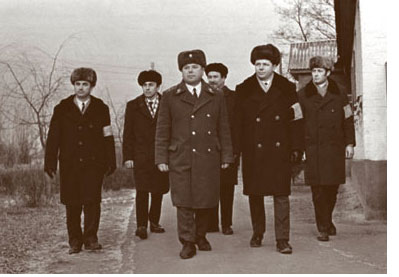
Druzhinniki in Estonia in the 1980s.
In surveys made by the Public Opinion Foundation in Russia last year, 64% said druzhinniki were necessary; 31% did not see the need for them. Fifty-five percent of Russians said they weren’t opposed to having the druzinniki check their documents in the presence of police. But 62% did not want them searching their personal belongings or automobiles.
Asked what the druzhinniki were supposed to do, 11% said they were supposed to “help people” and 9% said they were police helpers; 5% said they should “monitor the behavior of children and youths on the street.”
— Catherine A. Fitzpatrick